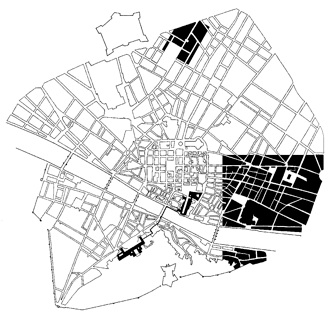Two Proposals, Florence Italy
Situations in the built environment whose latent potential can be revealed through minimal intervention is the impetus for two Florentine speculations. Initial interest was piqued by Michelangelo’s famous description of the sculptor’s task as discovering a statue already existent within a block of stone, and albeit on a grand scale, the essentially simple way the Uffizi (1) reveals the relationship between Florence’s most important public spaces—the Piazza della Signoria and the Arno River itself. Contemporary inspirations include the Castelgrande restoration in Bellinzona, Switzerland, where Aurelio Galfetti “created” a powerful natural facade on the main piazza by simply removing vegetation from the castle rock, and Thomas Bartel’s winning Harvard Gate Competition entry, where he proposed rehabilitating an existing and ignored gate on the site, rather than creating a new one.
It is felt this modest approach to urban design has relevance to contemporary practice. Two sites—the Santa Caterina church (2) and the Murate Quarter (3)—were identified for their potential of having the largest effect with the least means.
Santa Caterina d’Alessandria is a minor church in a drab section of the historic center, fronted by a piazza which, in typical fashion, is divided by a busy street and used as a parking lot. Of interest are the hints of ideality in this obscure context—the regular footprint of the space and its axial relationship to the unfinished church facade, reinforced by two large columns of unknown origin.
The first intention is simply to make the space usable by rerouting traffic around the block. Secondly, it is regularized with a new paving pattern and a consistent finish of the vertical surfaces to a datum set by the columns’ height. The subtlety of the interventions is important, partially for pragmatic reasons, but primarily to enhance but not erase the delicate tension between ideality and circumstance which is the most intriguing feature of the site.

